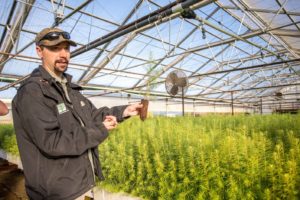Wildfire and smoke can affect all Oregonians. We’re with you.
Stay up to date on all things wildfire by checking out our resources page and signing up for alerts!
Healthy forests start with specialized seedlings
Managing and caring for a forest happens long before the tree is planted in the ground.
In Oregon, where more than 40 million seedlings are planted every year, most healthy forests start in a highly specialized nursery. Oregon Forests Forever recently toured Weyerhaeuser’s 300-acre seed orchard and seedling nursery in the Willamette Valley to learn about the birth, growth and planting of our healthy forests.
Hand-planted seedlings are often the best way to regrow a forest because they have already been given a strong start in a nursery, which gives them a better chance to thrive when they are planted in the forest. Weyerhaeuser’s nursery regularly handles orders of anywhere from 5,000 to 200,000 seedlings to replant forests throughout Oregon and Washington. At the time of our visit on a chilly March morning, the nursery had 4.7 million seeds sprouting in the greenhouse and 2.5 million growing in the nursery beds. That’s still just a fraction of the 40 million trees that are replanted in Oregon every year.

There’s plenty of variety in those seedlings, too. The nursery includes seedlings for several different species of trees, including Douglas-fir, Noble Fir, Cedar, Hemlock and Ponderosa pine. Even within the same species, seedlings need to be optimized for various climates and elevations, so the nursery produces seedlings for at least thirteen different growing regions in Oregon and Washington.
There’s plenty of variety in those seedlings, too. The nursery includes seedlings for several different species of trees, including Douglas-fir, Noble Fir, Cedar, Hemlock and Ponderosa pine.
In this particular seedling orchard, over 100 acres of fully mature trees provide cones full of seeds every year, some of which have been in the ground since the 1970s. While they produce seeds for the nursery, they also provide ideal habitat for wild birds, including heron, red tail hawks, and owls.
“Each seedling is the result of selecting the healthiest parent trees, so they grow quickly and produce quality wood, similar to how apple orchards are managed to produce better fruit,” said Anya Hall, Seed Orchard Manager with Weyerhaeuser. “We’re also selecting for trees that are less susceptible to diseases, and foresters plant a mix of seedlings, so the seedlings that are planted are the result of dozens of different high-quality parent trees.”
It takes special care and maintenance to produce these healthy seedlings, Hall explains. All cones are handpicked from the parent trees in the seed orchard each year, and then seeds are hand-sewn, watered and placed in the greenhouse to sprout. After the seedlings germinate, they’re transferred to open-air greenhouses for a year, and some are transplanted into the nursery beds for foresters who want larger seedlings before heading out to the woods. The whole process, starting from seed, takes four years before the seedlings even make it to their ultimate destination in the woods. This work creates roughly 100 jobs that pay above minimum wage at this nursery alone, and Weyerhaeuser has four nurseries throughout Western Oregon and Western Washington. Independent nurseries also provide seedlings for other forestry companies.
This look at Weyerhaeuser’s nursery is a great insight into the process to manage Oregon’s healthy and sustainable forests.
